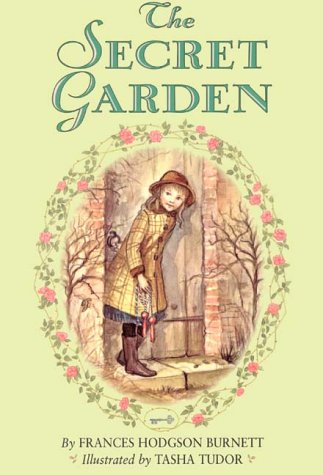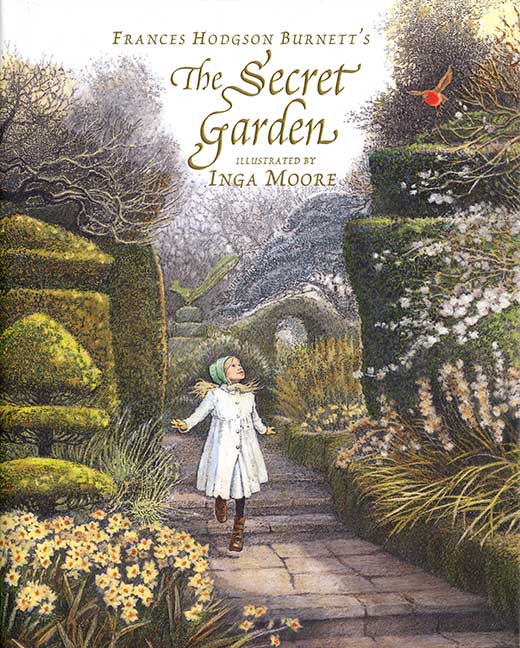Is The Secret Garden A Newbery Winner
 #15 The Secret Garden by Frances Hodgson Burnett (1911)
#15 The Secret Garden by Frances Hodgson Burnett (1911)
88 points
This the very first book I read by myself, and my dad insists I read this book to him over 1000 times. It's one of the few picture books I keep on my shelf, rather than my son's. – Erin Moehring
Back before having small children zapped my time/attention span, I read this every year around March. Because it feels like spring. And "Here Comes the Sun" is my favorite song. These may be related. – Amy M. Weir
How nice to start a book with an irritating child instead of a lovable one. And Mary's plea, "Might I have a bit of earth?" has been calling across the decades to hundreds of young readers who long for—something. It took Frances Hodgson Burnett to give that yearning a shape, and even if the shape isn't quite what a particular child might ultimately choose, the reader knows the feeling for what it is. This is a book about hope. Its old-fashioned plot about Colin being healed rather mystically is almost beside the point. There's just something magical about that secret garden. – Kate Coombs
Coming in at #8 on the previous poll, Mary Lennox slips a little, leaving wide open another spot on the top ten. Meanwhile this is almost a perfect children's book.
The synopsis from the publisher reads, "Has any story ever dared to begin by calling its heroine, 'the most disagreeable-looking child ever seen' and, just a few sentences later, 'as tyrannical and selfish a little pig as ever lived?' Mary Lennox is the 'little pig,' sent to Misselthwaite Manor, on the Yorkshire moors, to live with her uncle after her parents die of cholera. There she discovers her sickly cousin Colin, who is equally obnoxious and imperious. Both love no one because they have never been loved. They are the book's spiritual secret gardens, needing only the right kind of care to bloom into lovely children. Mary also discovers a literal secret garden, hidden behind a locked gate on her uncle's estate, neglected for the ten years since Colin's birth and his mother's death. Together with a local child named Dickon, Mary and Colin transform the garden into a paradise bursting with life and color. Through their newfound mutual love of nature, they nurture each other, until they are brought back to health and happiness."
A.S. Byatt once referred to Frances Hodgson Burnett as "Perhaps the first truly transatlantic writer." This may strike you as strange, until you know the woman's history. When The Secret Garden was written Ms. Burnett was living in . . . wait for it . . Long Island, New York! Tis true. According to Elizabeth Keyster in the October 1991 edition of Hollins Critic, " An Anglo-American, Burnett came to the United States while in her teens, returned to England for nine years in midlife, then spent the remainder of her life in this country." By this point in her career she'd already written Little Lord Fauntleroy and A Little Princess so her reputation was secure. According to Anita Silvey's 100 Best Books for Children, "First serialized in American Magazine, the story appeared under the title 'Mistress Mary.' It sold out its first edition even before publication and was widely read by adult fans of Burnett's earlier books, but it achieved little notoriety during the author's life." Instead, she got far more praise for Fauntleroy of all things. Says Silvey, "In fact, her New York Times obituary never even mentioned The Secret Garden." Sacrilege!
Burnett reportedly loved anything by the Bronte sisters. This sort of makes perfect sense when you think of the title's gothic underpinnings. And in the book Frances Hodgson Burnett by Phyllis Bixler, the author makes a series of rather good points about the book. For example: "In Little Lord Fauntleroy, she had portrayed a child reunited with his estranged family, and in Little Princess, she had portrayed an orphan who finds a new family. The Secret Garden has both." And later, "In Mary Lennox, Burnett created her most complex fictional child."
But it is A.S. Byatt who really pinpoints a lot of what I love about it. "Burnett's children's books have lasted because of an unfakeable quality of precise realism and observation–combined with an equally unfakeable hopefulness about the human condition. Burnett once observed that children like things–that was why she kept her doll's houses full of delicate models of life. That was why she took such care with the details both of Sara Crewe's possessions as a little rich girl (which another Victorian moralist might have sneered at) and with the things that she has, and the food that she has not, in her days as a slave in the attic. Little Lord Fauntleroy, a not-rich American boy suddenly confronted with English aristocratic possessions and customs, retains a grave curiosity about all this as well as a belief that people can be reasonable and kind which, despite the sentiment, are both oddly convincing. There is none of the sentimentality in Dickon, the country boy who understands creatures and plants, that there is in J M Barrie's eternal children."
Our own former National Ambassador of Young People's Literature Katherine Paterson is a fan of the book as well. In fact, in Silvey's Everything I Need to Know I Learned From a Children's Book, Paterson chose this title as her favorite. She writes, "In The Sense of Wonder, Rachel Carson says: 'If I had influence with the good fairy who is supposed to preside over the christening of all children, I should ask that her gift to each child in the world be a sense of wonder so indestructible that it would last throughout life, as an unfailing antidote against the boredom and disenchantment of later years, their sterile preoccupation with things that are artificial, the alienation from the sources of our strength.' This was surely the gift The Secret Garden gave to me as a child, and although I'm no good fairy, it is a gift I seek to share."
Not that you can't find objections to it, of course. In the aforementioned book Frances Hodgson Burnett by Phyllis Bixler, "The Secret Garden has its flaws. Some readers might object to its sentimental idealization of poverty and the class system in its portrayal of the Sowerby family and the gardener, Ben Weatherstaff. In a brief, uncharacteristic foray into fantasy, Burnett shows events in the garden through the consciousness of the robin and his mate, and she approaches her frequent silliness when personifying animals. Near the end, Burnett mechanically and unnecessarily interprets the garden as a symbol for the human mind; this discussion of the mind's power—the danger of locking it up, the necessity of weeding out bad thoughts to plant good ones—is undoubtedly the reason some contemporary readers considered The Secret Garden a Christian Science book." Never really thought of it that way before. And that doesn't even get into how colonialism has been viewed. Indeed, anyone who wants to know more about this might do well to check out the article "The Mem Sahib, the Worthy, the Rajah and His Minions: Some Reflections on the Class Politics of The Secret Garden" by Jerry Phillips in the December 1993 edition of Lion and the Unicorn.
In the course of my research into this book I hit upon one fact that stopped me cold. A.S. Byatt writes in the April 19, 2004 edition of New Statesman, "Gretchen Gerzina begins her biography of Frances Hodgson Burnett in 1925 with the commissioning of a fountain in New York's Central Park depicting Mary and Dickon from The Secret Garden." Wait . . . what? I've been in Central Park many many times over the years. I know about the two Alice in Wonderland statues and the Hans Christian Andersen. I even know about poor Balto, so how is it possible that there's a Secret Garden statue I've never heard of before? Well, I don't know how I missed it but there most certainly IS a Burnett Memorial Fountain in the Conservatory Garden area. According to Central Park, when Frances Hodgson Burnett died in 1924 people decided to honor her memory with a storytelling area in Central Park. Too bad we use Mr. Andersen instead these days (NYPL librarians tell stories in front of his statue all summer long). The theory is that these two folks in the Burnett Fountain are Dickon and Mary. I don't quite buy it. Not unless Mary suddenly decided the whole wearing clothes thing was getting old.
This year author Ellen Potter has penned her own take on The Secret Garden called The Humming Room. It's contemporary but folks familiar with the original will recognize all the essential beats.
Literary Digest said of the book at the time, "To describe adequately the delights of the story would deprive the reader of the joy and pleasure of first discovery–the sensation of surprise."
And now, the many faces of Mary.




























Now there have been lots of filmed versions of the movie out there. If you'd like a quickie glance at them, some enterprising soul posted the same scene of Mary meeting Dickon from the 1949, 1975, 1987, and 1993 versions respectively. In my personal opinion, the 1987 Hallmark version was the most regrettable of the adaptations. Any cinematic version that ends with Mary coming back after WWI to marry her cousin Colin and lament that Dickon got shot in a trench somewhere . . . *shudder* I always thought that the 1975 BBC production, while it has perhaps one of the worst first scenes, had the best looking Mary hands down.
There was also this 1993 version which I never seen. One wonders if that fire briefly glimpsed was a huge plot point.
In the event that you would like to have your eyes roll entirely backwards within your own skull, I recommend you watch this trailer for Back to the Secret Garden. Americans and winking rabbits. It doesn't get much better/worse than this.
Finally, I used to watch this Tony Award selection from The Secret Garden over and over when I was a kid. Good times. Good musical.
http://www.youtube.com/watch?v=h7_a5nqWC_c&feature=embed
Now tell me "Lily's Eyes" doesn't apply directly to the final Harry Potter book.
Is The Secret Garden A Newbery Winner
Source: https://blogs.slj.com/afuse8production/2012/06/13/top-100-childrens-novels-15-the-secret-garden-by-frances-hodgson-burnett/
Posted by: rogersocke2001.blogspot.com

0 Response to "Is The Secret Garden A Newbery Winner"
Post a Comment